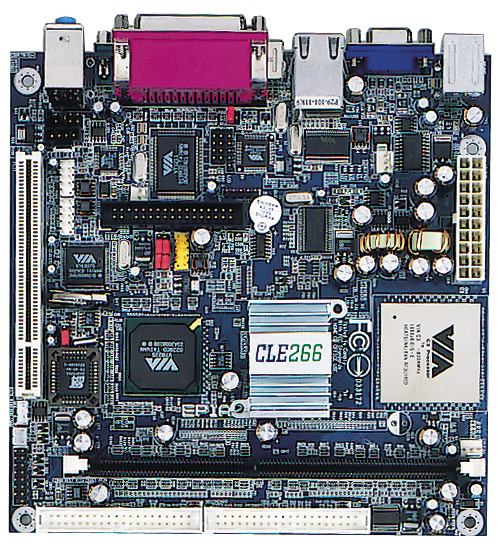
The One Has Arrived, Continued, Page 2
But hey, no guts, no glory, and the guts were indeed glorious because I used an Epia M10000 motherboard from Via that has about a $160 street price. The 6.7” square, Mini-ITX form factor M10000 is Intel 86 compatible. The motherboard uses Via’s proprietary 1GHz C3 "Nehemiah" processor whose EBGA packaging is soldered right onto the board. There is no way you are going to swap this little puppy out for a new CPU upgrade short of using a blowtorch. Via’s new Nehemiah CPU has just over 20 million transistors and a 16-stage pipeline, versus Intel's older Pentium III processor and its 10-stage pipeline, and the Pentium 4, whose pipeline is 20 stages. The Nehemiah uses 1.4V and this voltage pops the initial Nehemiah core out at a nice round 1Ghz. The 1Ghz downside is that unlike its Via CPU predecessors, the Nehemiah CPU requires active cooling. But the tiny “fansink” mounted on top of the Nehemiah CPU is so quiet as to make it virtually a non-issue.
VIA also built a hardware random number generator into the Nehemiah C3 core. The number generator figures into VIA's PadLock Data Encryption Engine, which could potentially be used for securing digital rights and protecting content, encrypting messages, etc. But right now anyway, it’s merely interesting to know it’s there, as it currently does nothing for the end user.
Besides Antec, a number of case manufacturers support the M10000’s tiny form factor. The Mini-ITX board has two IDE ports in addition to a floppy controller port, and a single DIMM slot. Having two IDE ports is good, because if there were only one IDE port, you would have to run a single master-slave cable combination with an optical drive and a hard drive. In that kind of cable set up, the cable connection speed drops down to the data transfer rate of the slowest device, typically the optical drive, so you lose all the high speed transfer goodness of the hard drive. On the downside, the EPIA-M10000 lacks Serial ATA support. In any event, I used one of Maxtor’s huge and highly recommended 250GB IDE hard drives that are superb for multimedia storage and playback. Fortunately, the newest version of the Epia M10000 BIOS supports large capacity drives like the Maxtor so you can use all 250GB.

The M10000 supports up to 1GB of DDR266 or DDR200 memory, which means memory is cheap and you can finally use that older, slower RAM the cat has been chewing on. But in this case, I had an extra 256MB stick of Corsair’s high performance XMS RAM that I used. It’s overkill, true, but this specialty RAM worked just fine.
The back panel of the M10000 is jammed with ports. In addition to the usual PS2 mouse and keyboard ports, parallel and serial ports, and a VGA connector there are also connectors for 2 USB 2.0 ports, a 10/100 MB/sec RJ45 LAN port, one RCA port that does double duty as either an SPDIF or TV out port, one S video port, and three audio jacks, including line-out, line-in and mic-in. If you want IEEE 1394 connections, you have to hook up either the Via-supplied full height PCI multi-port expansion bracket to the two 1394 connectors on the M10000 board, or you can use one of the board’s two connectors to hook up the 1394 port on the Aria’s front panel.
Sadly, there is no DVI-D video connector on the M10000’s back panel. There is only VGA and S-Video available, although you can also run a dual display setup, including configurations such a TV and an LCD panel. (The latest M10000 BIOS supports flat panel displays.)
21st, The VXM Network, https://vxm.com
